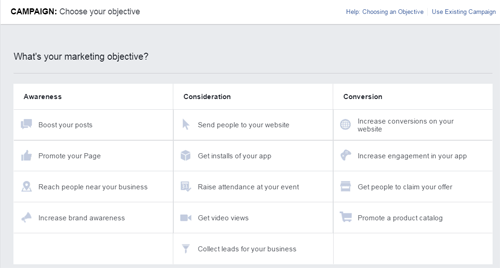In the name of "user experience," Facebook continues to limit what people see from brands in their news feeds - leaving many companies to consider how to "pay to play" on the social network since they can't rely on organic reach.
For those businesses that have yet to run a Facebook ad, let the following serve as a five-step guide to getting started.
1. Prioritize Goals
Before heading to Facebook Ads Manager, companies should determine what goals they have for their campaign(s) as this will set the foundation for the entire initiative. Common goals for Facebook ads fall under three categories.
Awareness:
Boost your posts, promote your page, reach people near your business, increase general brand awareness
Consideration:
Send people to your website, get installs of your app, raise attendance at your event, get view views, collect leads
Conversion:
Increase conversions on your website, increase engagement in your app, get people to claim your offer, promote a product catalog
Once on Facebook Ads Manager, click on "create ad." Facebook will require brands to choose one of the above options before naming their campaigns and then building it.

2. Set Parameters
With goals on hand, businesses now need to set the parameters of their campaign like who will it reach, how much are they willing to spend to reach them and for how long. For those creating their very first Facebook ad, it'd be wise to use this as an experiment of sorts and keep the budget low.
Brands will learn something about how to advertise on Facebook with their first $5-a-day campaign. For this first campaign, brands should consider setting a start and end date, such as Monday-Friday at $5 a day to spend $25 total. Later on, they can have continuously running campaigns and larger budgets but this will keep expectations in check and will allow marketers to make mistakes that won't be costly.
As for audiences, since this is a $25 campaign, consider experimenting with audiences outside of those who already like a Page on Facebook. Why not go after people who have shown interest in competitors? Also, the more specific the audience, the further a company's dollar will go.
3. Create Content
With campaign goals set and audience, budget and duration all determined, it's now time to build the campaign. While Facebook Ads Manager has a terrific "preview" feature to allow marketers to see what their campaigns will actually look like on the network, brainstorming should take place off the network for now.
While the campaign goals set in step one will determine how the content looks (e.g., boosted post vs. conversion-focused ad designed to send traffic to a website). Some content elements to consider include the post text, image and description (the thumbnail type info).
When crafting content, start with image choice. Don't select anything that's not genuine. Stock photo services are certainly improving, but keep a focus on genuinely connecting with an audience with an image. Since images play a huge role in capturing people's attention on Facebook, really prioritize this.
Perhaps it's a customer's photo they've given a brand permission to use or a staff photo.
By choosing an image first, marketers may feel more inspired to write copy.
4. Define Tracking
The most important part of a company's first Facebook ad is including tracking parameters like including a source-rich URL built in Google Analytics (GA), which can be tracked within the goals previously set up in GA (e.g., whitepaper downloads, sales).
Facebook also makes it easy to track campaigns. Early on when setting up an ad, Facebook will ask about whether its pixel is installed on the company's website. It's just a snippet of code that companies can install in the HTML of a page they want visitors to go to (learn more here).
5. Keep Monitoring
During and after the campaign runs, brands will want to monitor the performance of their ads in order to evaluate how the message is resonating and how well it's performing in terms of actual traffic, sales and their initial goals.
Facebook provides some great reporting options, but hopefully brands will take this time (if they haven't already) to understand the importance of third-party tracking like through GA or a customer relationship management system because this data will paint a bigger picture of exactly how much sales, leads, etc., have been brought in from the campaign.
